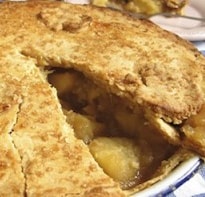Puff or shortcrust, cooking apples or dessert, cream or custard - and can plain old apple pie compete with tarte tatin and strudel?
When something is described as "as American as apple pie", it simply means that no one remembers exactly which immigrant group brought it with them - and where the apple pie is concerned, those mellow mists of time are more like a fruitful fog, because it's been a staple in the States since before those states existed.Indeed, the Oxford Encyclopedia of Food and Drink in America suggests that the typical American version of this classic dessert descends from "15th-century English pies" and ideas brought over by the earliest colonial settlers.Having looked at a few medieval recipes, many of which involve sugar, sweet spices, and butter, I'd go so far as to suggest that the typical British pie hasn't moved on much either, and with good reason. If the pie ain't broke, then you may as well eat it.
Apples
Once upon a time, the pie would have been made with whatever variety of apple you happened to have in the orchard, woods or local market. This presumably accounts for the vague reference to "some apples" in the family recipe included in Florence White's 1932 Good Things in England.Advertisement
Pastry
Grigson uses puff, while everyone else chooses a variety of crumbly shortcrust, which, though less visually impressive, I prefer - the rich stodginess is a better match for the autumnal apple. Given this is a dish better served warm or cool than piping hot, the shortcrust keeps better too.Advertisement
Advertisement
Filling and flavourings
Grigson adds raisins to her filling, some of which I decide to soak in rum in obedience to Annie Bell's recipe. They look pretty, but I find them too sweet, booze or no booze - unlike White's rose petals, which get entirely lost in the welter of other ingredients. If you'd like a floral note in your pie, a little rosewater would be a better bet.Sweet spices are still popular; White and Day-Lewis use cloves, Day-Lewis and Wareing cinnamon, and Day-Lewis also sticks in nutmeg. Her pie is too heavily spiced for my liking, but just a hint perks the whole thing up considerably without detracting from the apples.The same goes for sugar: Day-Lewis uses a mixture of dark and light muscovado, but the treacly bitterness of the latter is overpowering. The light brown sugar, however, adds a more interesting, caramel flavour. As extra insurance against that apple flavour getting lost, I'm taking a tip from White's recipe, and stewing the cores and peel in water to make a kind of apple stock, which gives her pie a marvellously intense flavour. It may sound like a bit of a faff, but given you have to peel and core them anyway, it's only a matter of sticking the results in a pan of water and leaving them to bubble for 15 minutes, and the results are truly remarkable.Advertisement
The perfect apple pie
(Serves 6-8)4 bramley apples
2 tbsp butter, plus extra to grease
1 cinnamon stick
4 cloves
125-150g light muscovado sugar, depending on taste
3 cox's apples
Nutmeg
1 tbsp flour
1 tbsp demerara or granulated sugar
1 egg white, beaten
For the pastry
350g spelt or plain flour, plus extra to dust
190g cold butter, grated
1 egg plus 1 yolk, beaten
1 lemonPeel and core the bramleys, reserving both. Cut the flesh into chunks. Melt one tablespoon of butter in a saucepan and add the cinnamon stick and cloves. Fry for a couple of minutes, until aromatic, then add the chunks of apple, plus 100g of the sugar. Cook, uncovered, stirring occasionally, for about 30 minutes until the mixture is fluffy and fairly dry.Meanwhile, put the cores and peel in a small pan and just cover with cold water. Bring to the boil, then turn down the heat and simmer for 15 minutes. Allow both this and the compote to cool, then remove the cinnamon stick and cloves from the compote (if you can find them).To make the pastry, put the flour in a large mixing bowl and add the grated butter and a generous pinch of salt. Rub in the butter to the consistency of fine breadcrumbs, then stir in the egg and the finely grated zest of the lemon until you have a dough (or you could use a food processor). Wrap well and chill for 30 minutes.Meanwhile, peel and core the cox's and cut them into chunks. Stir these into the stewed bramleys along with the juice of half a lemon, 50ml of the apple stock, a grating of nutmeg and the remaining muscovado (start with 125g sugar, and add more if you think it is too sharp).Preheat the oven to 180C. Grease a large pie dish with butter, and roll out two-thirds of the pastry to about 5mm thick. Use to line the dish. Sprinkle the base with one tablespoon of flour and one tablespoon of sugar. Top with the apple mixture and dot the top with small pieces of the remaining butter.Roll out the remaining pastry to 5mm thick. Brush the rim of the pastry base with egg white, and then top with this lid, pressing down to seal. Trim the edges (use these trimmings to decorate if you wish), and cut a small hole in the middle. Brush with egg white and sprinkle with sugar. Bake for 35-45 minutes until golden, then allow to cool a little before serving.Can apple pie compare to the fancy likes of a tarte tatin or an apple strudel? Do you prefer puff or shortcrust, flaky or filo - and has anyone ever had a mock apple pie?Photo: Felicity Cloake's perfect apple pie. Photographs: Felicity Cloake for the Guardian
For the latest food news, health tips and recipes, like us on Facebook or follow us on Twitter and YouTube.
Advertisement
